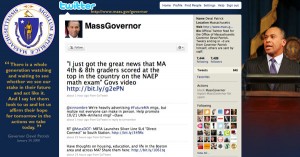A Politician’s Role in the Twitterverse: Follower to Friend Ratio
It all began with a tweet from a college friend:
“Should Politicians follow all of their own followers? What do you think? Should mutual following be a priority for politicians on #twitter?”
To which I responded simply ““ “No” and in my limited 140 characters explained that it isn’t beneficial for any person, let alone a politician to follow everyone due to the large number of “spam tweeters” and non-active users. And so began our Twitter discussion on the role politicians should play within the greater Twitterverse, and how they may view their own roles as part of the greater community.
Politicians are just like other tweeters, are they not? They use Twitter to share and disseminate information, while also striving to stay current and absorb additional news. Twitter is also a new way to hear from district and national constituents on specific issues that are being discussed. The real issue is that every politician approaches their use of Twitter differently, some don’t even utilize it at all.
To Follow and/or to Be Followed? – That is the Question
Let’s get back to the original debate, whether or not politicians should be following all of their own followers. My friend pointed to Senator Bernie Sanders (I-VT), who currently has 25,594 followers and is only following 275 tweeters. Sen. Sander’s Twitter fame recently skyrocketed during his 10+ hour filibuster that earned him the hashtag “#filibernie.” This is a perfect example of how a politician should be utilizing Twitter, but that hashtag probably wasn’t created by the Senator (who was obviously busy) or his staff. The wave of support and matching hashtag was more likely to have been organically grown by a political supporter on Twitter.
of how a politician should be utilizing Twitter, but that hashtag probably wasn’t created by the Senator (who was obviously busy) or his staff. The wave of support and matching hashtag was more likely to have been organically grown by a political supporter on Twitter.
That being said, my friend still believes it to be inexcusable for an elected official to only be following 275 groups/individuals on Twitter. Before the Senator’s #filibernie fame he had 6,000 followers, which is still a fairly sizeable gap in comparison to the number of tweeters he follows. Given that a Senator has staffers dedicated to specific policy and constituent needs, the task of tweeting and social media is usually one left by default to an intern or entry-level staffer. This is a positive in that the staffer/intern is usually of Gen Y or a Millennial and more versed in social media, but at the same time, it means limited time and resources are dedicated.
Besides tweeting between 1 and 5 times a day, I’m sure the Senator’s staff was unprepared for the avalanche of followers and simply chose to ignore/delete emails instead of looking at who was following. Nor did they check to see how many people used the #filibernie hashtag. This is entirely understandable, but on a regular day it shouldn’t take too much time to simply see if the follower is interesting enough or worthy of following back. Maybe even have that intern create a Twitter list to organize VT constituents, political advocates or organizations the Senator follows ““ the photocopying can wait.
Social media analytics platforms created a simple ratio to speak to the relationship between followers & those who are followed. Many look at the number of people that are following a given Twitter user as an indicator of that user’s authority. In turn, the number of Twitter users that a particular user is following (That user’s “friends” in classic Twitter lingo) provides context for the follower/friend ration.
Governor Markell of Delaware has a following of 1,790 Twitter users. He, in turn, is following 789 Twitter users, (also expressed as “has friended 789 Twitter users”). 1,798 / 789 = 2.27. This is Governor Markell’s “follower/friend” ratio.
- A ratio of less than 1.0 indicates that you are seeking knowledge (and Twitter Friends), but not getting much Twitter Love in return.
- A ratio of around 1.0 means you are respected among your peers. Many people think that a ratio of around 1.0 is the best – you’re listening and being listened to.
- A ratio of 2.0 or above shows that you are a popular person and people want to hear what you have to say. You might be a thought leader in your community.
- A TFF Ratio 10 or higher indicates that you’re either a Rock Star in your field or you are an elitist and you cannot be bothered by Twitter’s mindless chatter. You like to hear yourself talk. Luckily others like to hear you talk, too.
A higher ratio number provides an indication of a larger gap. The goal should be to maintain a low ratio/gap, above 1 and below 2. In order to bridge the gap and achieve a lower ratio, the user needs to create a balance.
In contrast to Governor Markell, Governor Patrick of Massachusetts has 14,446 followers and is following 11,672 Twitter users for a follower/friend ratio of 1.23. This demonstrates that Governor Patrick follows on Twitter far more aggressively than Governor Markell, which is likely why Governor Patrick has a comparatively larger following. Thus, while Governor Patrick has a much larger following, it appears as if social media tactics, as opposed to pure content or “celeb power” explain at least some of that difference. The time-tested means of building a Twitter following is to follow other users. Inevitably, a certain percentage of the people you follow will in-turn follow you back.
Governor Patrick follows on Twitter far more aggressively than Governor Markell, which is likely why Governor Patrick has a comparatively larger following. Thus, while Governor Patrick has a much larger following, it appears as if social media tactics, as opposed to pure content or “celeb power” explain at least some of that difference. The time-tested means of building a Twitter following is to follow other users. Inevitably, a certain percentage of the people you follow will in-turn follow you back.
When a politician responds in-kind to follow a Twitter user it can have an extremely positive effect on his/her image in that user’s eyes. People are often elated to find that a political icon has taken the time to follow them. An inbox message from Twitter that says “Barack Obama“ is following you on Twitter can do wonders for a person/organization’s ego. Extra points go to politicians that utilize direct messaging (dm) to converse with followers. By following in return, it’s a balance of authority that demonstrates the value of connecting with people on the ground level.
Next in this series of posts is — ” A Politician’s Role in the Twitterverse: Popularity vs. Influence”
This series of posts on a “Politician’s Role in the Twitterverse” was a joint collaboration between Sandi Fox, Smart As A Fox Consulting (@smartasafox) and Sean Hurley, Hear Forward (@seanphurley).
Comments are closed.